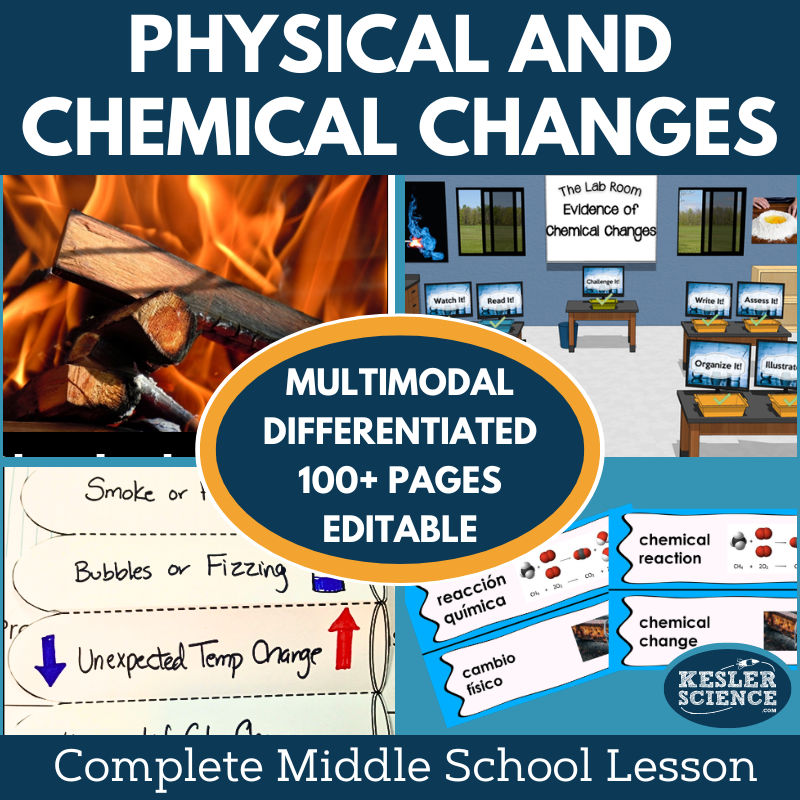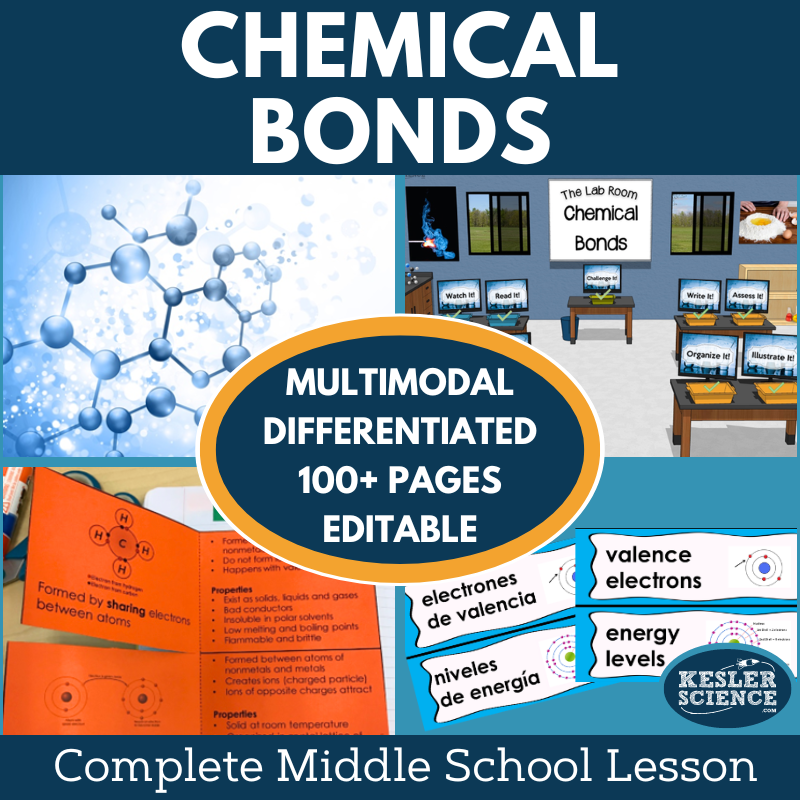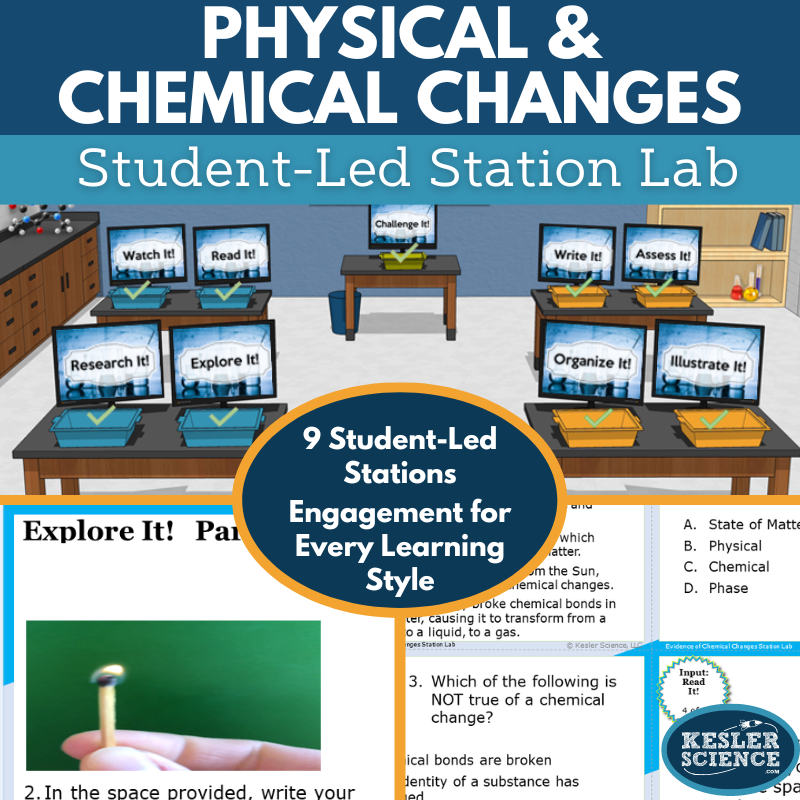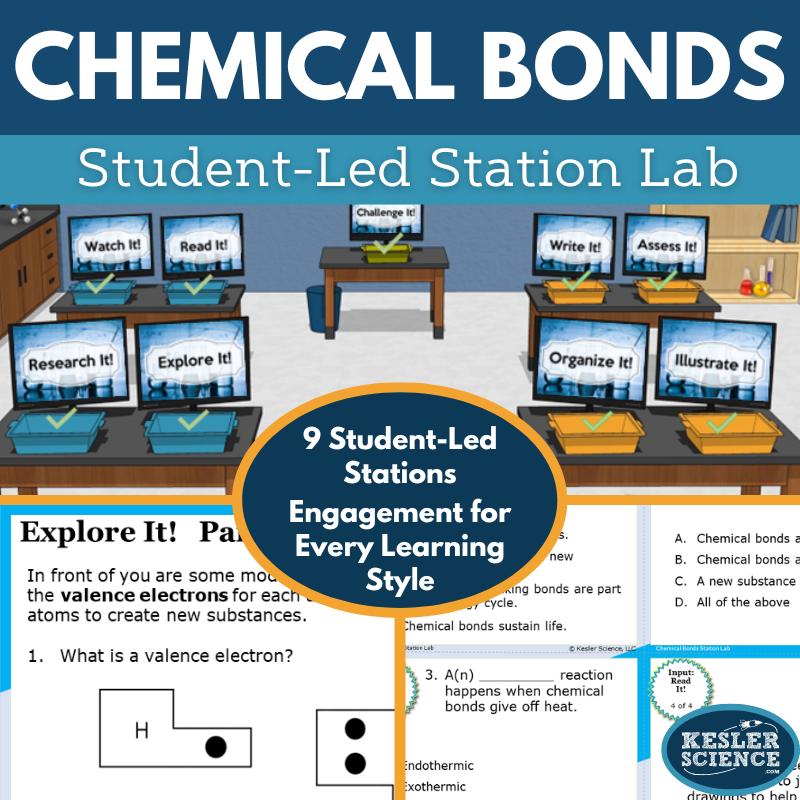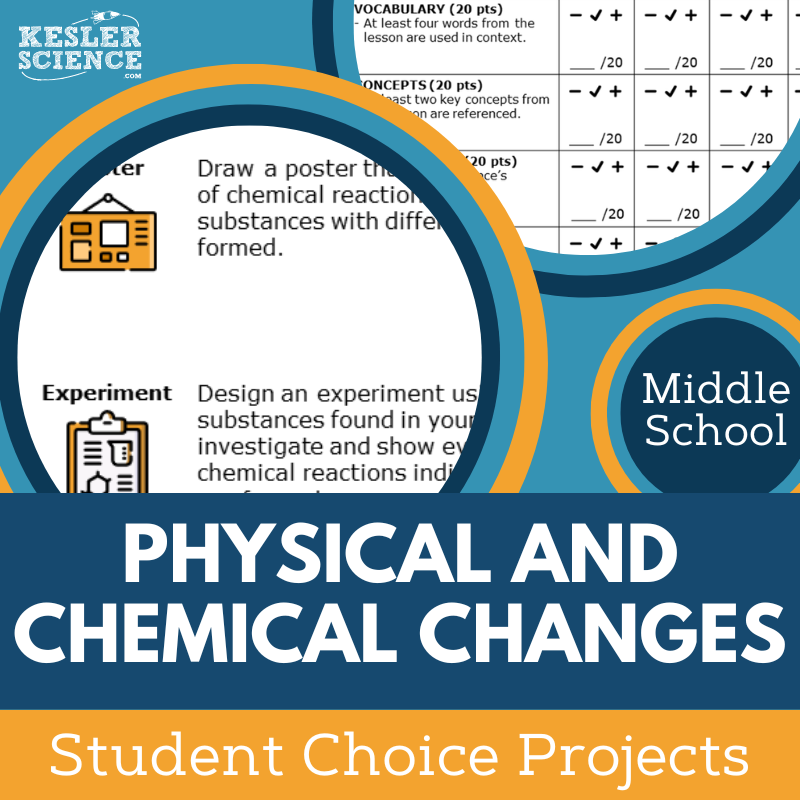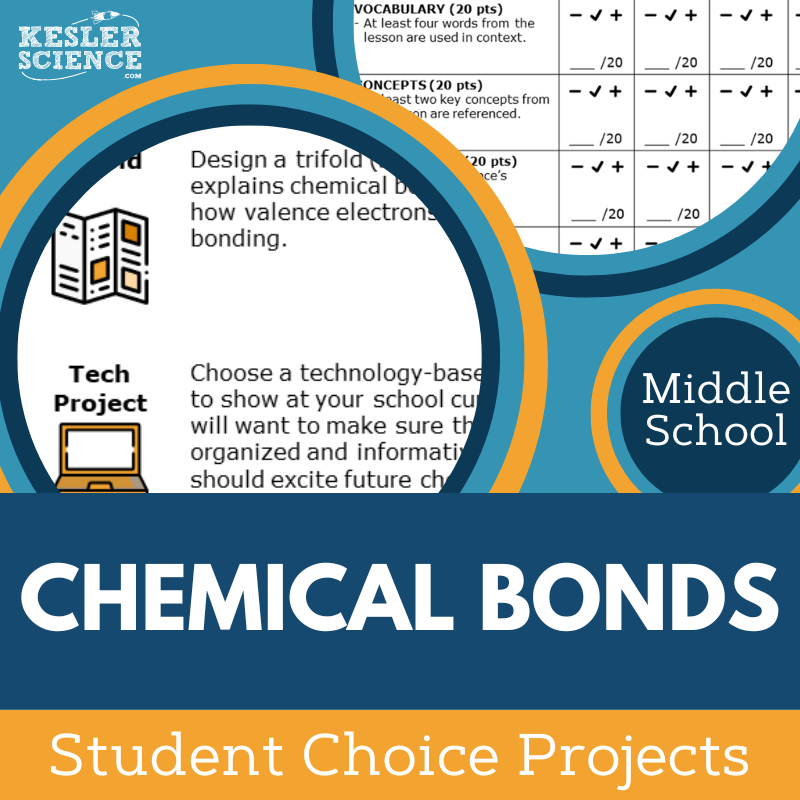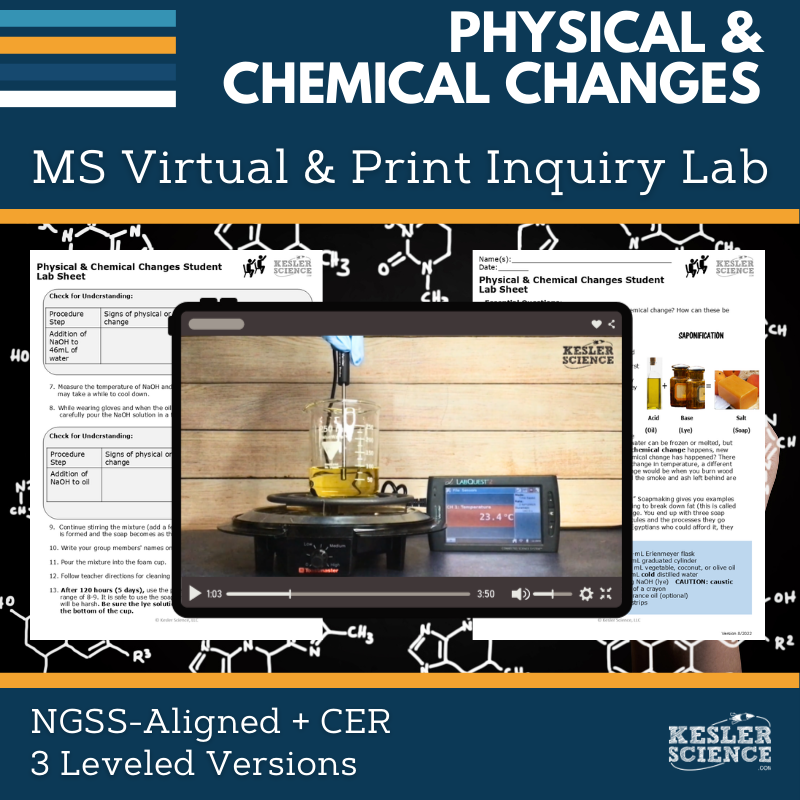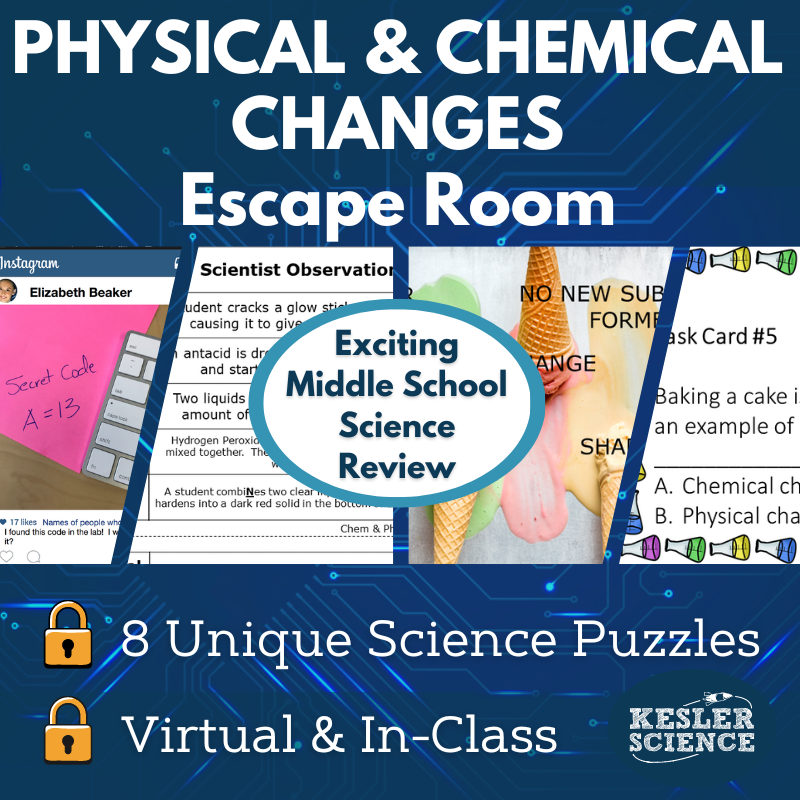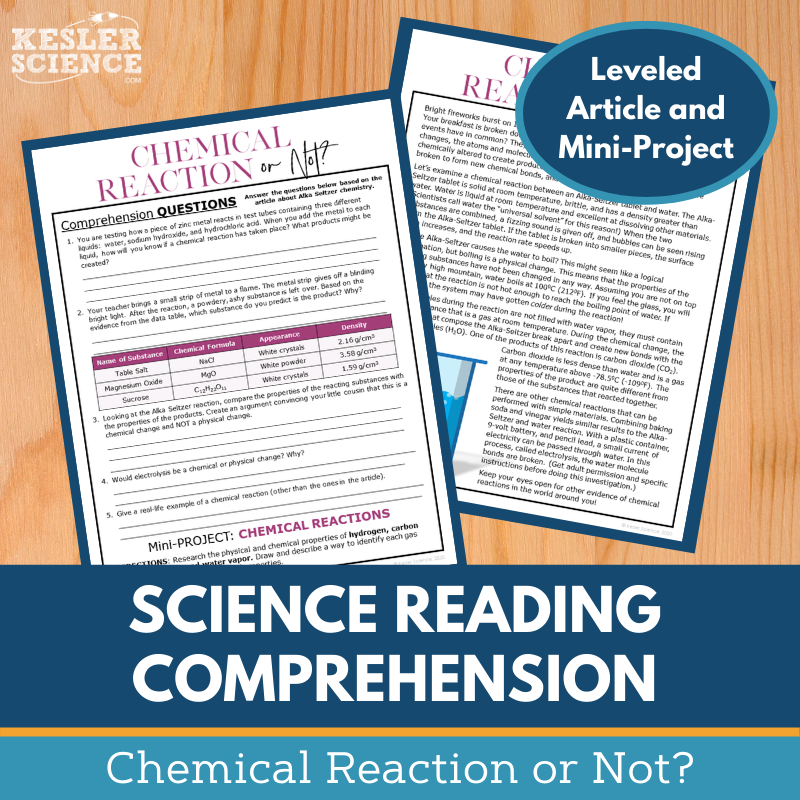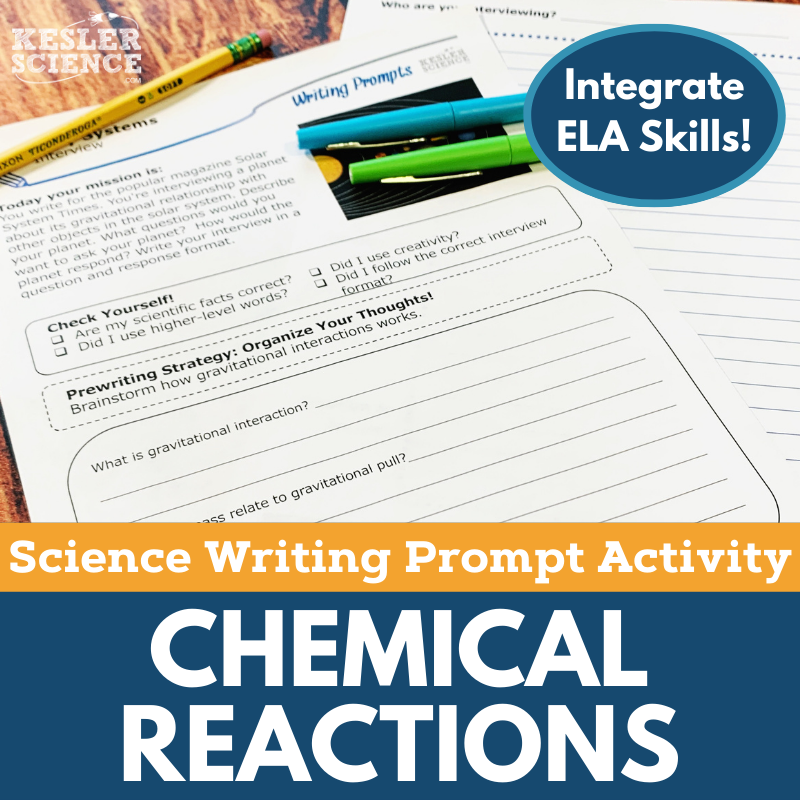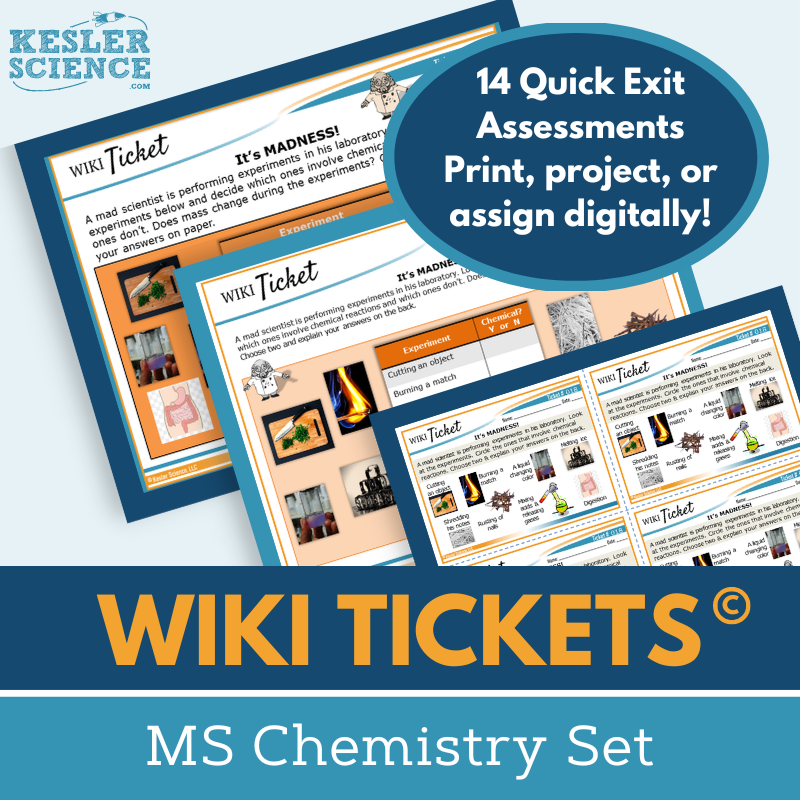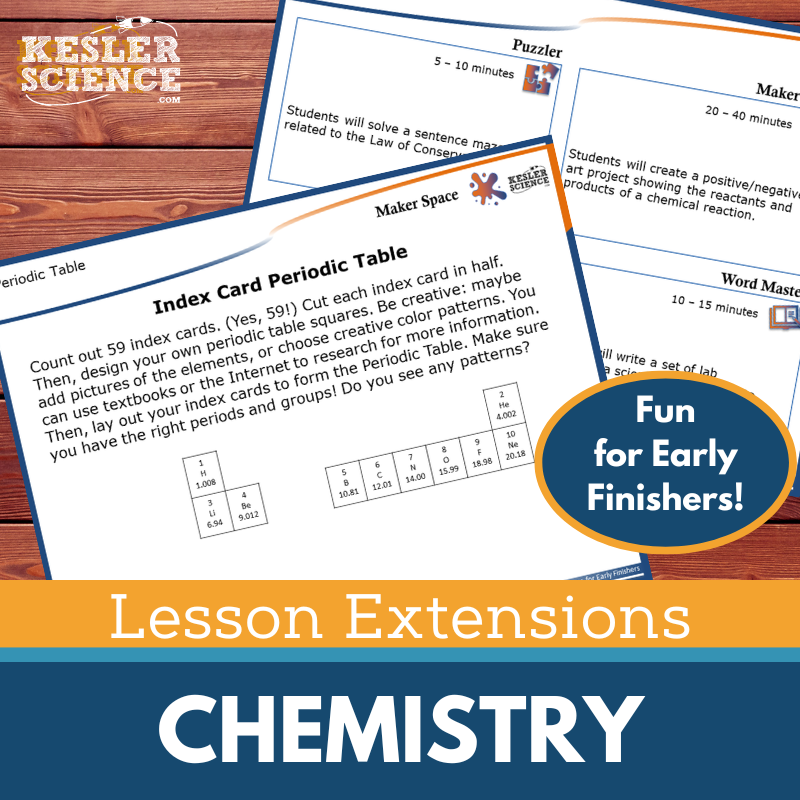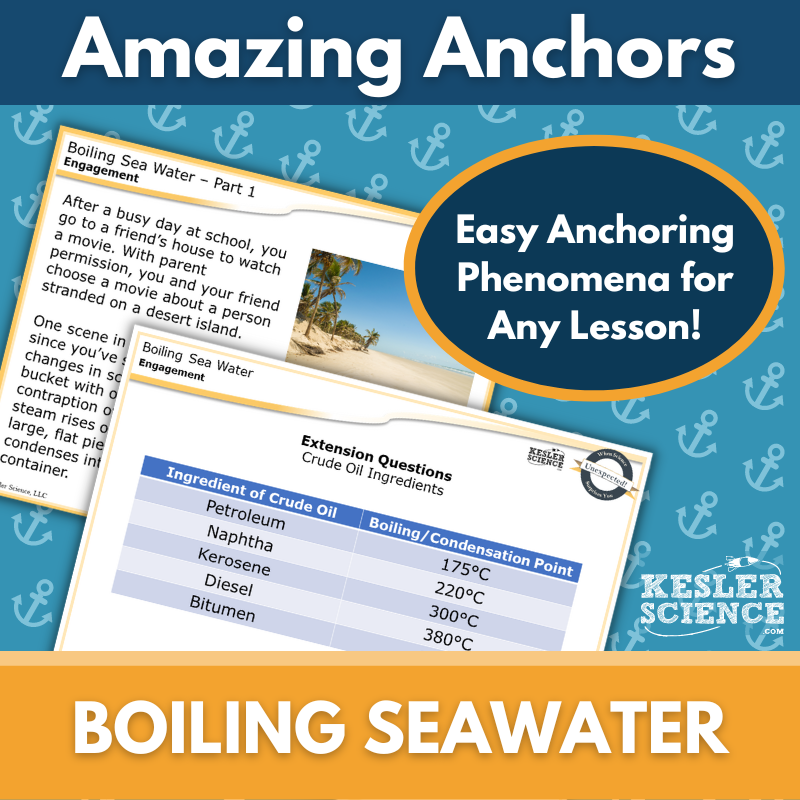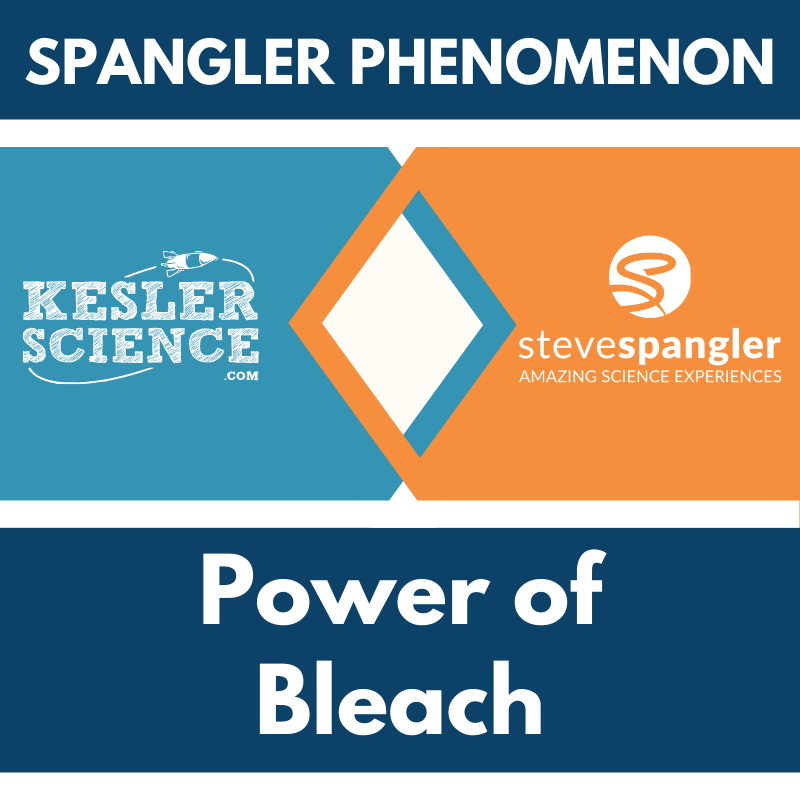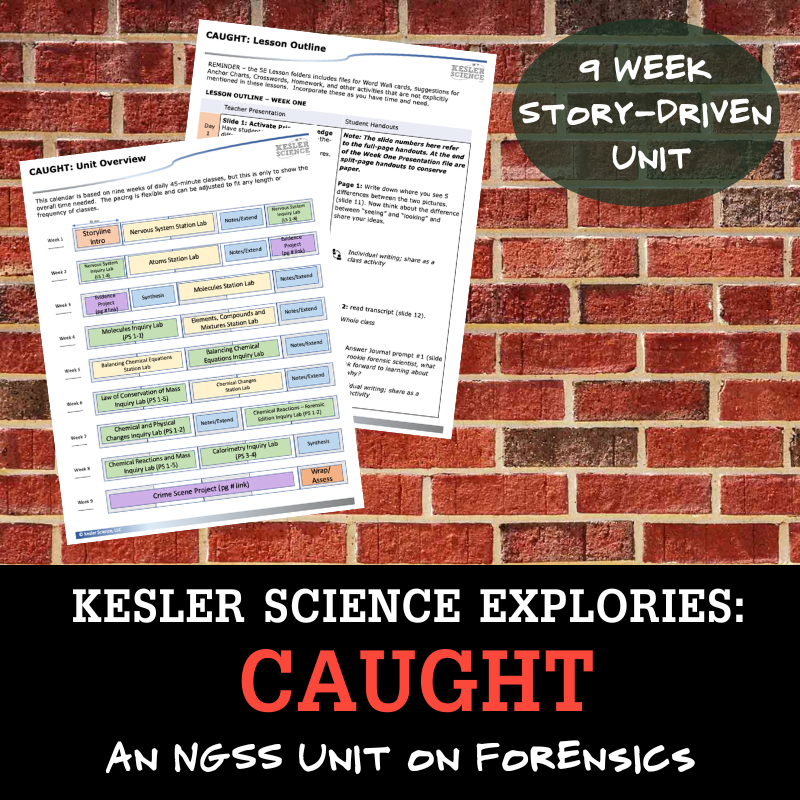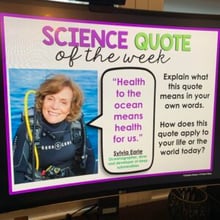Chemical Reaction Data Activities for Middle School Science
The Physical and Chemical Changes and Chemical Bonds 5E Lessons engage middle school students in exploring key chemistry concepts through a structured, student-led approach aligned with NGSS and TEKS standards. The resources below will give students a comprehensive understanding of chemical reactions. All of the following materials are also included in the Kesler Science Membership.
The Kesler Science Physical and Chemical Changes 5E Lesson is a comprehensive, student-led unit designed for middle school science. It includes editable presentations, worksheets, choice projects, and assessments, requiring minimal prep while supporting differentiated learning. Students explore how evidence of chemical reactions indicates the formation of new substances with different properties.
The lesson follows the 5E Model with engaging activities for each phase. The student-led Exploration station lab offers nine differentiated stations, including hands-on experiments, reading passages in English and Spanish, research tasks, videos, and creative output activities like sorting, writing, and illustrating. Editable PowerPoints and interactive notebooks support Explanation, while student-choice projects extend learning in the Elaboration phase. Evaluation includes STAAR 2.0-aligned assessments and review materials.
This resource is flexible for both in-class and virtual learning, with digital and printable formats available. Spanish translations are included for key materials. The lesson ensures multimodal learning, keeping students engaged while allowing teachers to focus on student success.
The Kesler Science Physical and Chemical Changes 5E Lesson is a comprehensive, student-led unit designed for middle school science. It includes editable presentations, worksheets, choice projects, and assessments, requiring minimal prep while supporting differentiated learning. Students explore how evidence of chemical reactions indicates the formation of new substances with different properties.
The lesson follows the 5E Model with engaging activities for each phase. The student-led Exploration station lab offers nine differentiated stations, including hands-on experiments, reading passages in English and Spanish, research tasks, videos, and creative output activities like sorting, writing, and illustrating. Editable PowerPoints and interactive notebooks support Explanation, while student-choice projects extend learning in the Elaboration phase. Evaluation includes STAAR 2.0-aligned assessments and review materials.
This resource is flexible for both in-class and virtual learning, with digital and printable formats available. Spanish translations are included for key materials. The lesson ensures multimodal learning, keeping students engaged while allowing teachers to focus on student success.
The Kesler Science Chemical Bonds 5E Lesson is a comprehensive middle school unit covering covalent and ionic bonding, valence electrons, and why compounds bond. It includes editable presentations, worksheets, choice projects, and assessments designed for differentiated, student-led learning with minimal prep. The lesson aligns with NGSS and TEKS standards.
Following the 5E Model, the unit offers engagement through discussion activities and word wall vocabulary in English and Spanish. Exploration includes a student-led station lab with nine stations, featuring hands-on experiments, readings, research tasks, videos, and creative outputs such as writing, illustration, and categorization. Explanation materials include editable PowerPoints, interactive notebook templates, and note-taking guides. Students extend their learning with choice projects and demonstrate mastery through assessments aligned with STAAR 2.0.
The lesson supports multimodal learning, offers Spanish translations for key materials, and provides both digital and printable formats for maximum flexibility. It is fully adaptable for virtual learning, ensuring students can engage with the content in any setting.
The Kesler Science Chemical Bonds 5E Lesson is a comprehensive middle school unit covering covalent and ionic bonding, valence electrons, and why compounds bond. It includes editable presentations, worksheets, choice projects, and assessments designed for differentiated, student-led learning with minimal prep. The lesson aligns with NGSS and TEKS standards.
Following the 5E Model, the unit offers engagement through discussion activities and word wall vocabulary in English and Spanish. Exploration includes a student-led station lab with nine stations, featuring hands-on experiments, readings, research tasks, videos, and creative outputs such as writing, illustration, and categorization. Explanation materials include editable PowerPoints, interactive notebook templates, and note-taking guides. Students extend their learning with choice projects and demonstrate mastery through assessments aligned with STAAR 2.0.
The lesson supports multimodal learning, offers Spanish translations for key materials, and provides both digital and printable formats for maximum flexibility. It is fully adaptable for virtual learning, ensuring students can engage with the content in any setting.
Engage your middle school students with this interactive, student-led station lab on physical and chemical changes. Designed to foster independent learning, this lesson guides students in identifying the formation of a new substance as evidence of a possible chemical change.
Featuring nine modular stations, this resource offers differentiated activities, including hands-on demonstrations, research, reading comprehension, video analysis, and creative tasks like sketching, writing, and organizing concepts. A challenge station provides extension activities for early finishers. Each station includes signage, task cards, and resources for individual or small-group work, with digital options available for virtual learning.
This low-prep, high-engagement lesson encourages students to explore, apply, and demonstrate their understanding of physical and chemical changes in a meaningful way.
Engage your middle school students with this interactive, student-led station lab on physical and chemical changes. Designed to foster independent learning, this lesson guides students in identifying the formation of a new substance as evidence of a possible chemical change.
Featuring nine modular stations, this resource offers differentiated activities, including hands-on demonstrations, research, reading comprehension, video analysis, and creative tasks like sketching, writing, and organizing concepts. A challenge station provides extension activities for early finishers. Each station includes signage, task cards, and resources for individual or small-group work, with digital options available for virtual learning.
This low-prep, high-engagement lesson encourages students to explore, apply, and demonstrate their understanding of physical and chemical changes in a meaningful way.
Engage your middle school students with this student-led station lab on chemical bonds, designed to promote active learning and independent exploration. Students will analyze and interpret data on the properties of substances before and after interactions through a variety of interactive stations.
This modular activity features eight differentiated stations, plus a ninth challenge station for early finishers. Students encounter new concepts through hands-on demonstrations, research tasks, reading passages, and videos, while also demonstrating their understanding by organizing information, illustrating models, writing responses, and completing assessments.
All stations include clear signage, literature, resources, and task cards, with minimal additional materials needed for hands-on exploration. The digital version allows for interactive engagement using PowerPoint or Google Slides. English and Spanish reading passages support differentiated learning, and the resource is adaptable for both in-class and virtual instruction.
Engage your middle school students with this student-led station lab on chemical bonds, designed to promote active learning and independent exploration. Students will analyze and interpret data on the properties of substances before and after interactions through a variety of interactive stations.
This modular activity features eight differentiated stations, plus a ninth challenge station for early finishers. Students encounter new concepts through hands-on demonstrations, research tasks, reading passages, and videos, while also demonstrating their understanding by organizing information, illustrating models, writing responses, and completing assessments.
All stations include clear signage, literature, resources, and task cards, with minimal additional materials needed for hands-on exploration. The digital version allows for interactive engagement using PowerPoint or Google Slides. English and Spanish reading passages support differentiated learning, and the resource is adaptable for both in-class and virtual instruction.
The Physical and Chemical Changes Student Choice Projects lesson allows middle school students to select a project that aligns with their preferred output style. A project page outlines six student-led options plus a “design your own” project, with an editable rubric for teacher, peer, or self-assessment.
These flexible, multimodal projects provide creative ways for students to demonstrate their understanding. Teachers can modify the rubric to fit grading needs, and two versions of the project page support differentiation. The modified version includes three options designed for students needing remediation, while advanced learners can complete multiple projects using the same rubric.
The projects require common classroom supplies like paper, markers, and scissors, with many options available for digital completion. Some projects may benefit from additional crafting materials for model-building.
The Physical and Chemical Changes Student Choice Projects lesson allows middle school students to select a project that aligns with their preferred output style. A project page outlines six student-led options plus a “design your own” project, with an editable rubric for teacher, peer, or self-assessment.
These flexible, multimodal projects provide creative ways for students to demonstrate their understanding. Teachers can modify the rubric to fit grading needs, and two versions of the project page support differentiation. The modified version includes three options designed for students needing remediation, while advanced learners can complete multiple projects using the same rubric.
The projects require common classroom supplies like paper, markers, and scissors, with many options available for digital completion. Some projects may benefit from additional crafting materials for model-building.
The Chemical Bonds Student Choice Projects lesson aligns with NGSS standards, allowing middle school students to select a project that fits their preferred output style. A project page outlines six student-led options plus a “design your own” project, with an editable rubric for teacher, peer, or self-assessment.
These flexible, multimodal projects give students creative ways to demonstrate their understanding. Two versions of the project page support differentiation, with modified options for students needing remediation and challenge options for advanced learners. Teachers can adjust the rubric to fit grading needs.
The projects use standard classroom supplies like paper, markers, and scissors, with many options available for digital completion. Some crafting materials may be helpful for model-building.
The Chemical Bonds Student Choice Projects lesson aligns with NGSS standards, allowing middle school students to select a project that fits their preferred output style. A project page outlines six student-led options plus a “design your own” project, with an editable rubric for teacher, peer, or self-assessment.
These flexible, multimodal projects give students creative ways to demonstrate their understanding. Two versions of the project page support differentiation, with modified options for students needing remediation and challenge options for advanced learners. Teachers can adjust the rubric to fit grading needs.
The projects use standard classroom supplies like paper, markers, and scissors, with many options available for digital completion. Some crafting materials may be helpful for model-building.
The Physical and Chemical Changes Inquiry Lab aligns with NGSS MS-PS1-2, helping students analyze and interpret data to determine if a chemical reaction has occurred. Students will distinguish between physical and chemical changes by completing the saponification process (making soap) and observing an exothermic reaction.
This lab offers both a hands-on printed experiment and a fully virtual version with an interactive PowerPoint and a pre-recorded lab demonstration. Both formats include comprehension questions, Claim-Evidence-Reasoning (C.E.R.) prompts, and a reflection section. Three differentiated levels—dependent, modified, and independent—ensure accessibility for all learners.
The print version provides structured, student-centered procedures, while the digital version allows for virtual participation without requiring materials. Editable PowerPoints, teacher resource pages, answer keys, and multimodal learning tools enhance flexibility. This engaging lab helps students explore chemical reactions through an interactive, inquiry-based approach.
The Physical and Chemical Changes Inquiry Lab aligns with NGSS MS-PS1-2, helping students analyze and interpret data to determine if a chemical reaction has occurred. Students will distinguish between physical and chemical changes by completing the saponification process (making soap) and observing an exothermic reaction.
This lab offers both a hands-on printed experiment and a fully virtual version with an interactive PowerPoint and a pre-recorded lab demonstration. Both formats include comprehension questions, Claim-Evidence-Reasoning (C.E.R.) prompts, and a reflection section. Three differentiated levels—dependent, modified, and independent—ensure accessibility for all learners.
The print version provides structured, student-centered procedures, while the digital version allows for virtual participation without requiring materials. Editable PowerPoints, teacher resource pages, answer keys, and multimodal learning tools enhance flexibility. This engaging lab helps students explore chemical reactions through an interactive, inquiry-based approach.
The Physical and Chemical Changes Escape Room is an interactive experience that allows students to demonstrate their understanding of chemical and physical changes. Before participating, students should be able to compare and contrast the characteristics of these changes.
Teachers have complete control over the activity, selecting from eight independent puzzles that can be arranged in any order, making it adaptable for different class periods. The escape room can be run using manila envelopes for a simple setup, or for a more immersive experience, teachers can incorporate lockout hasps, four-digit locks, and storage boxes. Both methods require printed materials, invisible ink pens or highlighters, brads for decoder rings, and QR readers with Internet access.
A digital version is available for individual student use via PowerPoint, which can also be uploaded to Google Slides. A printable version in PPT or PDF format allows families to participate at home. Copyright restrictions limit distribution to students only.
This resource includes teacher directions, a detailed answer key, a digital answer sheet (Google Form), and an editable teacher version. Students engage with a video challenge, printable props, and eight unique puzzles. Additional materials include reward templates, over 50 prize ideas, and 30 customizable signs for post-activity photos. This escape room is an exciting way to reinforce key science concepts while keeping students engaged.
The Physical and Chemical Changes Escape Room is an interactive experience that allows students to demonstrate their understanding of chemical and physical changes. Before participating, students should be able to compare and contrast the characteristics of these changes.
Teachers have complete control over the activity, selecting from eight independent puzzles that can be arranged in any order, making it adaptable for different class periods. The escape room can be run using manila envelopes for a simple setup, or for a more immersive experience, teachers can incorporate lockout hasps, four-digit locks, and storage boxes. Both methods require printed materials, invisible ink pens or highlighters, brads for decoder rings, and QR readers with Internet access.
A digital version is available for individual student use via PowerPoint, which can also be uploaded to Google Slides. A printable version in PPT or PDF format allows families to participate at home. Copyright restrictions limit distribution to students only.
This resource includes teacher directions, a detailed answer key, a digital answer sheet (Google Form), and an editable teacher version. Students engage with a video challenge, printable props, and eight unique puzzles. Additional materials include reward templates, over 50 prize ideas, and 30 customizable signs for post-activity photos. This escape room is an exciting way to reinforce key science concepts while keeping students engaged.
The Chemical Reaction or Not Science Reading Comprehension Lesson helps students explore how substances change before and after interactions to determine if a chemical reaction has occurred. Designed for middle school, the leveled passage enhances science literacy and reading comprehension.
Students read a nonfiction article on chemical reactions, answer five to seven comprehension questions, and research the physical and chemical properties of hydrogen, carbon dioxide, oxygen, and water vapor. The resource includes a hands-on mini-project, a Cornell notes template, and engaging graphics that can be printed in grayscale.
Perfect for sub plans, extra credit, ISS, or whole-class instruction, this resource fosters critical thinking, classroom discussions, and textual analysis. It is compatible with virtual learning platforms such as Google Classroom, MS Teams, Schoology, and Canvas, allowing students to respond directly in a digital format.
The Chemical Reaction or Not Science Reading Comprehension Lesson helps students explore how substances change before and after interactions to determine if a chemical reaction has occurred. Designed for middle school, the leveled passage enhances science literacy and reading comprehension.
Students read a nonfiction article on chemical reactions, answer five to seven comprehension questions, and research the physical and chemical properties of hydrogen, carbon dioxide, oxygen, and water vapor. The resource includes a hands-on mini-project, a Cornell notes template, and engaging graphics that can be printed in grayscale.
Perfect for sub plans, extra credit, ISS, or whole-class instruction, this resource fosters critical thinking, classroom discussions, and textual analysis. It is compatible with virtual learning platforms such as Google Classroom, MS Teams, Schoology, and Canvas, allowing students to respond directly in a digital format.
The Chemical Reactions Science Writing Prompt Activity engages middle school students in a creative narrative exercise to assess their understanding of physical science. Aligned with NGSS MS-PS1-2, this activity enhances science reasoning and writing skills while supporting both in-person and virtual learning.
This resource includes teacher directions with an answer guide, project ideas, and rubrics, along with projection and print handouts in both full-sized and half-sheet formats. A digital PowerPoint version, compatible with Google Slides, allows for flexible use in any learning environment. Ideal for cross-curricular activities, pre-test assessments, student choice projects, or enrichment for early finishers, this writing prompt fosters engagement and critical thinking. It can also be used for extra credit, make-up work, TELPAS samples, and differentiation. Designed for review, this activity assumes students have prior knowledge or access to research materials.
The Chemical Reactions Science Writing Prompt Activity engages middle school students in a creative narrative exercise to assess their understanding of physical science. Aligned with NGSS MS-PS1-2, this activity enhances science reasoning and writing skills while supporting both in-person and virtual learning.
This resource includes teacher directions with an answer guide, project ideas, and rubrics, along with projection and print handouts in both full-sized and half-sheet formats. A digital PowerPoint version, compatible with Google Slides, allows for flexible use in any learning environment. Ideal for cross-curricular activities, pre-test assessments, student choice projects, or enrichment for early finishers, this writing prompt fosters engagement and critical thinking. It can also be used for extra credit, make-up work, TELPAS samples, and differentiation. Designed for review, this activity assumes students have prior knowledge or access to research materials.
The WIKI Tickets© Formative Assessments offer engaging, flexible ways to check student understanding in 6th-8th grade science. This Chemistry Set includes 14 assessments, each available in five formats: a full-screen projection version, three print handouts, and an interactive digital version compatible with PowerPoint and Google Slides.
Aligned to NGSS and TEKS standards, these assessments cover key topics such as atomic structure, chemical changes, density, periodic table arrangement, and recognizing chemical reactions. Each standard has at least one ticket, with some topics featuring multiple assessments. A bonus table of contents file is included to show alignment.
Designed for both in-person and virtual learning, WIKI Tickets© can be used as exit tickets, bellringers, or quick checks. Students can respond on paper, printed handouts, or digitally in a 1:1 setting. These colorful, engaging assessments help you gauge student progress with ease.
The WIKI Tickets© Formative Assessments offer engaging, flexible ways to check student understanding in 6th-8th grade science. This Chemistry Set includes 14 assessments, each available in five formats: a full-screen projection version, three print handouts, and an interactive digital version compatible with PowerPoint and Google Slides.
Aligned to NGSS and TEKS standards, these assessments cover key topics such as atomic structure, chemical changes, density, periodic table arrangement, and recognizing chemical reactions. Each standard has at least one ticket, with some topics featuring multiple assessments. A bonus table of contents file is included to show alignment.
Designed for both in-person and virtual learning, WIKI Tickets© can be used as exit tickets, bellringers, or quick checks. Students can respond on paper, printed handouts, or digitally in a 1:1 setting. These colorful, engaging assessments help you gauge student progress with ease.
Lesson Extensions provide engaging, student-choice activities designed to challenge early finishers while reinforcing critical thinking and creativity. These activities help wrap up lessons, fill downtime during testing, and keep students engaged with rigorous yet enjoyable learning opportunities aligned to NGSS and TEKS chemistry standards.
Each extension includes four interactive components: Puzzler for problem-solving, Maker Space for hands-on STEAM activities, Tech Connection for digital media demonstrations, and Word Master for creative writing. Teacher directions, answer keys, and both print and projection versions ensure flexibility in the classroom.
Covering topics such as atomic structures, chemical reactions, the periodic table, and synthetic materials, these extensions provide high-level enrichment for independent learners ready to explore chemistry concepts more deeply.
Lesson Extensions provide engaging, student-choice activities designed to challenge early finishers while reinforcing critical thinking and creativity. These activities help wrap up lessons, fill downtime during testing, and keep students engaged with rigorous yet enjoyable learning opportunities aligned to NGSS and TEKS chemistry standards.
Each extension includes four interactive components: Puzzler for problem-solving, Maker Space for hands-on STEAM activities, Tech Connection for digital media demonstrations, and Word Master for creative writing. Teacher directions, answer keys, and both print and projection versions ensure flexibility in the classroom.
Covering topics such as atomic structures, chemical reactions, the periodic table, and synthetic materials, these extensions provide high-level enrichment for independent learners ready to explore chemistry concepts more deeply.
This Amazing Anchors Phenomenon Lesson introduces chemical reactions through a real-world scenario of boiling seawater on a deserted island. The two-part resource includes an introductory reading with comprehension and extension questions to prepare students for learning, followed by an explanatory reading that breaks down the science behind chemical reactions with additional reinforcement questions.
Designed to align with NGSS standard MS PS1-2, this no-prep resource includes teacher directions, answer keys, projection slides, and both digital and print formats for flexible use in classrooms or on LMS platforms. A differentiated version provides sentence starters to support student comprehension. These engaging readings serve as an effective supplement to any lesson, fitting seamlessly into the Engagement and Elaborate segments of a 5E lesson structure.
This Amazing Anchors Phenomenon Lesson introduces chemical reactions through a real-world scenario of boiling seawater on a deserted island. The two-part resource includes an introductory reading with comprehension and extension questions to prepare students for learning, followed by an explanatory reading that breaks down the science behind chemical reactions with additional reinforcement questions.
Designed to align with NGSS standard MS PS1-2, this no-prep resource includes teacher directions, answer keys, projection slides, and both digital and print formats for flexible use in classrooms or on LMS platforms. A differentiated version provides sentence starters to support student comprehension. These engaging readings serve as an effective supplement to any lesson, fitting seamlessly into the Engagement and Elaborate segments of a 5E lesson structure.
This Spangler Phenomenon lesson on chemical reactions features an exclusive Steve Spangler video, engaging students with the question: What pattern do reactions between materials follow? Designed using the 5E framework, this lesson aligns with middle school NGSS physical science.
In Part 1, students observe chemical reactions by adding food coloring to liquids, inspired by the Power of Bleach video. In Part 2, they analyze an article on chemical reactions and can extend their learning with additional labs. In Part 3, they refine their conclusions after watching a Steve Spangler explanation video and demonstrate understanding through writing, drawing, or building activities.
The lesson includes teacher directions, student handouts, two Steve Spangler videos, clear presentation slides in standard and interactive formats, and PowerPoint files compatible with Google Slides. Vimeo links ensure an ad-free viewing experience.
This Spangler Phenomenon lesson on chemical reactions features an exclusive Steve Spangler video, engaging students with the question: What pattern do reactions between materials follow? Designed using the 5E framework, this lesson aligns with middle school NGSS physical science.
In Part 1, students observe chemical reactions by adding food coloring to liquids, inspired by the Power of Bleach video. In Part 2, they analyze an article on chemical reactions and can extend their learning with additional labs. In Part 3, they refine their conclusions after watching a Steve Spangler explanation video and demonstrate understanding through writing, drawing, or building activities.
The lesson includes teacher directions, student handouts, two Steve Spangler videos, clear presentation slides in standard and interactive formats, and PowerPoint files compatible with Google Slides. Vimeo links ensure an ad-free viewing experience.
"Explories: CAUGHT” is an NGSS unit that immerses students in a Forensics Academy, where they learn chemistry principles and evidence-gathering skills to solve a non-violent crime. Through this interactive experience, students progress through training levels, earning badges as they develop investigative techniques. They begin with an introduction to the nervous system and sensory processes before moving on to crime scene evidence collection and analysis. Chemistry lessons equip students with the skills to examine substances like lipstick and blood, culminating in the creation of a Rookie Handbook that aids them in solving their first case with a field partner.
This unit includes day-by-day teacher instructions, two unit projects, six station labs, eight inquiry labs, six 5E lessons, student activity pages, project-based and traditional assessments, rubrics for feedback and standards-based grading, journaling and synthesis activities, and two training videos on how to use the files. It aligns with NGSS standards related to atomic structure, chemical reactions, conservation of mass, energy transfer, and sensory processing.
"Explories: CAUGHT” is an NGSS unit that immerses students in a Forensics Academy, where they learn chemistry principles and evidence-gathering skills to solve a non-violent crime. Through this interactive experience, students progress through training levels, earning badges as they develop investigative techniques. They begin with an introduction to the nervous system and sensory processes before moving on to crime scene evidence collection and analysis. Chemistry lessons equip students with the skills to examine substances like lipstick and blood, culminating in the creation of a Rookie Handbook that aids them in solving their first case with a field partner.
This unit includes day-by-day teacher instructions, two unit projects, six station labs, eight inquiry labs, six 5E lessons, student activity pages, project-based and traditional assessments, rubrics for feedback and standards-based grading, journaling and synthesis activities, and two training videos on how to use the files. It aligns with NGSS standards related to atomic structure, chemical reactions, conservation of mass, energy transfer, and sensory processing.
Year-Round Resources
These year-round activities will increase your students' understanding of many middle school science topics. All of these activities are also included in the Kesler Science Membership.
Visual Data & Graphing
You're not alone if your students struggle with understanding graphs, charts, and tables. It's a skill that takes an enormous amount of practice. This resource will help students build a strong foundation in analyzing data and creating their own data visualizations.
Bell Ringers and Warm-Ups
These middle school science bell ringers are an excellent way to engage your students as soon as they walk into your classroom. This comprehensive FULL YEAR resource includes everything you need to start off each science class with an interesting warm-up activity.
Review Board Games
Each game board has been carefully designed to keep students engaged. There are 10 different action spaces on each board and dozens of question cards. All of the actions are related to science concepts and keep the students motivated throughout the game.
Each game is ready to play. Simply print out the board and the cards and let the students enjoy reviewing nine different units.
Essential Questions and Standards
Below are the essential questions and standards associated with the lessons and activities included in the chemical reactions data unit. This topic is only one of more than 100 middle school science topics included in the Kesler Science Membership.
-
How does evidence of chemical reactions indicate that new substances with different properties are formed?
-
Why do compounds bond?
-
How are valence electrons related to chemical bonds?
-
What is covalent bonding?
-
What is ionic bonding?
-
NGSS - MS-PS1-2 Chemical Reaction Data
Kesler Science Membership
Imagine never having to search for another middle school science lesson again. The membership gives you access to ALL of the Kesler Science products in one place (Yes, including everything above).
Say goodbye to long hours of lesson prep.

